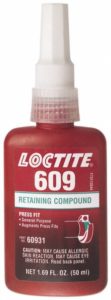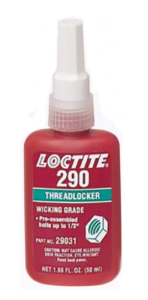Anaerobic adhesives offer an excellent way to adhere metal components in the absence of oxygen, without the need for light or heat. Because of their unique properties, anaerobic adhesives are applied mainly as threadlockers – to fix bolts and screws in metal assemblies. They can also be used in airtight plastic assemblies like those with nylon threads, with the use of an activator. Anaerobic adhesives also have secondary properties that make them advantageous as a sealant in those applications. These adhesives are a useful alternative in other tight-fitting metal-metal connections where press or shrink – fits would have been the only other method of connection.
Anaerobic adhesives are an acrylic polymer that bonds in the presence of metal ions. Oxygen inhibits the cure of these adhesives, which makes them ideal for threadlocking applications. Because bolts can back out, particularly under stresses like vibration in vehicles or aviation, threadlockers are often used to combat those stresses. While anaerobic adhesives usually need clean surfaces to adhere to, surface-insensitive formulations are available, as well as surface primers that can promote adhesion under different circumstances. These adhesives generally cure to fixture in minutes, curing fully within 24 hours. Application of heat can increase cure times. These adhesives generally come in specialty, air-permeable plastic containers and are only filled halfway to prevent premature curing. Transferring an anaerobic to another container or syringe can cause pre-mature curing and process difficulty. Care should be taken in handling anaerobic adhesives since they are reactive monomers and can cause potential skin damage.
Strengths
 These adhesives are formulated in a number of different strengths. Choosing the strength of adhesives depends on a number of factors. First is the width of the bolt. Larger bolts mean larger shear forces, so strong adhesives are needed to resist those forces. Aside from size considerations, use is an important factor. If screws or bolts will need to be removed for later servicing or disassembly, weaker threadlockers need to be used that will prevent incidental backing-out, but not intentional removal. On the other hand, permanent or semi-permanent anaerobic adhesives that bond surfaces that do not later need to be removed are available. Some formulations release bonds only under high-heat, allowing extremely high adhesion, as well as removability.
These adhesives are formulated in a number of different strengths. Choosing the strength of adhesives depends on a number of factors. First is the width of the bolt. Larger bolts mean larger shear forces, so strong adhesives are needed to resist those forces. Aside from size considerations, use is an important factor. If screws or bolts will need to be removed for later servicing or disassembly, weaker threadlockers need to be used that will prevent incidental backing-out, but not intentional removal. On the other hand, permanent or semi-permanent anaerobic adhesives that bond surfaces that do not later need to be removed are available. Some formulations release bonds only under high-heat, allowing extremely high adhesion, as well as removability.
Retaining Compounds
Although threadlocking represents a large portion of the anaerobic adhesive use, these adhesives can be used in any tight-fitting metal-metal bonding application. Assemblies that would usually be attached with shrink-fits can use anaerobic adhesives to bond pieces. This allows those assemblies to avoid some problems involved with expansion and contraction, and increases tolerance thresholds for machining of parts.
Special formulations
 While the average threadlocker is applicable in most bolt-retaining applications, there are specialty formulations that meet the needs of particular assemblies. Viscosity can be altered in threadlockers, and very low viscosity formulations are useful for adding threadlockers to already-assembled components.
While the average threadlocker is applicable in most bolt-retaining applications, there are specialty formulations that meet the needs of particular assemblies. Viscosity can be altered in threadlockers, and very low viscosity formulations are useful for adding threadlockers to already-assembled components.
Higher viscosities can, to an extent, fill gaps, if a higher-than-normal space between threads is expected. Anaerobic adhesives usually have an operating temperature range to around 150C, but high-temperature adhesives can push that upper limit to above 200C.
Additional advantages
Anaerobic adhesives have a few properties that increase their value and utility beyond simple thread locking. Most importantly, threadlockers coat threads entirely and are resistant to water, solvents and oils. This allows threadlockers to serve the dual-purpose as sealants and prevent corrosion from liquids and gases that would otherwise compromise bolted assemblies. Because anaerobic adhesives don’t cure in the presence of oxygen, cleanup is easy since any excess adhesive remains as an easily wiped-away liquid.
 Shop our range of Anaerobic Adhesives here.
Shop our range of Anaerobic Adhesives here.
The content for this month’s blog post was provided by Gluespec® – a partner of Ellsworth Adhesives.
Gluespec helps engineers to discover adhesives and other materials for their industrial applications.
